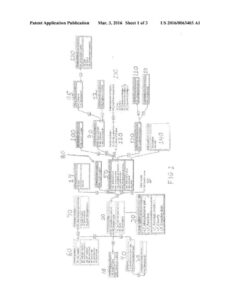IN RE JASON SMITH, FEDERAL CIRCUIT 2022 (SOFTWARE PATENTS)
 Mr. Smith’s argued that the first step in analyzing a claim must be to determine whether the claim is useful. And if it is useful, it is by law patent-eligible. The Federal Circuit disagreed.
Mr. Smith’s argued that the first step in analyzing a claim must be to determine whether the claim is useful. And if it is useful, it is by law patent-eligible. The Federal Circuit disagreed.
The U.S. Patent and Trademark Office rejected claims of Jason Smith’s patent application as patent ineligible under 35 U.S.C. § 101. The Patent Trial and Appeal Board affirmed the rejection. Mr. Smith appealed to the Federal Circuit.
Mr. Smith’s patent application Serial No. 14/786,244 (Publication No. 2016/0063403) relates to software for asset acquisition and management.
Claim is representative and recites:
- A method for facilitating asset acquisition, asset management and asset maintenance whereby customers can purchase from multiple vendors comprising:
- providing to vendor and customer users access to consortium management software;
providing and maintaining in said consortium management software relational data base tables which are linked together, including a vendor/customer database table, whereby vendor users and customer users can enter their identifying and personal data, and a searchable product catalogue database table; - providing in said searchable product catalogue database for receipt from vendor users, product, product pricing and product maintenance data;
- providing an inventory database table and a customer asset management database table;
- providing customer users access to said searchable product catalogue database, whereby a customer searches the catalogue data base and purchases from any vendor user product selected from said product catalogue database;
providing for association of any said user’s identifying data with information in any database table,
which information is pertinent only to a particular said identified user with said users identifying
data; - [and] linking the purchasing customer’s identifying information from the customer/vendor database table, and the product, product pricing and product maintenance data for the selected product or products, to one or both of said inventory database table and/or said customer asset management data base table, such that the customer can retrieve, use and manipulate the product, product pricing and product maintenance data in connection with the management of the assets purchased.
If you have read any of the other posts in Malhotra Law Firm’s History of Software Patents, you will be well aware that the Supreme Court has set forth a two-step framework for analyzing patent eligibility in Alice Corp. Pty. Ltd.
v. CLS Bank Int’l, First, in Alice Step 1, the Federal Circuit is to determine whether the claims at issue are directed to patent-ineligible concepts such as laws of nature, natural phenomena, and abstract ideas. If so, in Alice Step 2, the Federal Circuit is to examine the elements of each claim, considered both individually and as an ordered combination, for an “inventive concept” sufficient to transform the nature of the claim into a patent eligible application.
The Appeals Board had analyzed claim 1 under the two-step Alice inquiry and determined it was ineligible under § 101. At step one, the Board determined that each of the steps in the claim relate to storing vendor/customer information, product information, and asset management information, associating the various items of information with other items of information, and enabling the retrieval of any information and any of its associated information. It further found that such data organization is akin to collecting data, analyzing the data (e.g., associating and/or linking certain data), and displaying results (e.g., the requested data and any linked or associated data), which the Federal Circuit in earlier similar cases found patent ineligible at step one of Alice. At step two, the Board determined that “to the extent claim 1 includes
additional elements, any such additional elements include only conventional computer components” and that these elements, when considered individually and as an ordered combination, are well-understood, routine, conventional
activity in the field and are not specified beyond a high level of generality.
The Federal Circuit saw no error in the Appeals Board’s analysis. The Federal Circuit has routinely held that claims that are directed to collection of information, comprehending the meaning of that collected information, and indication of the results, all on a generic computer network operating in its normal, expected manner are claims to abstract ideas. The Federal Circuit reached such a conclusion in cases such as In re Killian; Electric Power Group, LLC v. Alstom S.A.; Intellectual Ventures I LLC v. Capital One Financial Corp.; and In re TLI Communications LLC Patent Litigation. Regarding Alice step two, the Federal Circuit stated that nothing in the claim recites an inventive concept to transform the abstract idea into a patent-eligible application. The claim recites generic computer functions, which the specification describes are carried out by conventional computer components and can be implemented using existing technologies.
Mr. Smith’s argued that the first step in analyzing a claim to a new process or an improvement thereof must be to determine whether it is useful and that if it is useful, it is by law patent eligible. It is an interesting argument and Professor Michael Risch, in his paper A Surprisingly Useful Requirement has suggested such an approach. Unfortunately for Mr. Smith, the courts have never adopted that kind of test. I would personally recommend focusing on just obviousness. If a claim has a high level of generality, it may well be possible to reject it on obviousness grounds. But the Federal Circuit has not asked me for my opinion.
There are two lessons here. Where possible, try to describe and claim how the software improves computer performance. If no such arguments can be thought up, describe and claim software processes in detail, beyond a high level of generality. If you need help protecting your software, contact Malhotra Law Firm, PLLC.